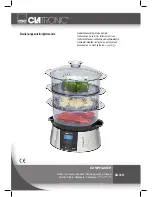
10
Disposal
Battery Removal
When your recharge-
able clipper reaches
the end of its useful
life, the batteries
must be removed
and recycled or
disposed of properly
in accordance with your local and state
requirements.
The following procedure should be
followed for battery removal:
■
Make sure your clipper
is unplugged from any
outlets so you don’t risk
an electric shock.
■
Remove the clipper
guard and remove
the blade assembly.
■
Using a small Phillips
head screwdriver,
remove the 4 screws
from the clipper’s back
cover.
■
Remove the metal spring
clip using a screwdriver
or pliers. Face unit away
from you when removing.
■
Pull or gently pry the clipper halves
apart, exposing the batteries.
■
Pull or pry batteries from PC board.
■
Twist batteries to break wires. Wires
may also be cut.
BATTERY MUST BE RECYCLED
OR DISPOSED OF PROPERLY.
Ni-Cd
CONTAINS NICKEL-
CADMIUM BATTERY.
CAUTION: THESE NICKEL-CADMIUM
BATTERIES MUST BE RECYCLED
OR DISPOSED OF IN ACCORDANCE WITH
STATE AND LOCAL REGULATIONS.
Do not burn or mutilate, as they may burst
or release toxic materials. Do not short-
circuit, as this may cause burns.
The EPA-certified RBRC
®
Battery Recycling
Seal on the nickel-cadmium (Ni-Cd) battery
indicates Remington Products Company,
L.L.C. is voluntarily participating in an
industry program to collect and recycle
these batteries at the end of their useful
life, when taken out of service in the United
States or Canada. The RBRC
®
program
provides a convenient alternative to placing
used Ni-Cd batteries into the trash or the
municipal waste stream, which may be
illegal in your area. Please call
1-800-8-BATTERY
SM
for information on
Ni-Cd battery recycling and disposal
bans/restriction in your area. Remington
Products Company, L.L.C.’s involvement
in this program is part of our commitment
to preserving our environment and
conserving our natural resources.











































